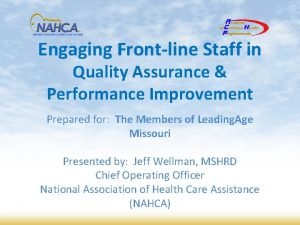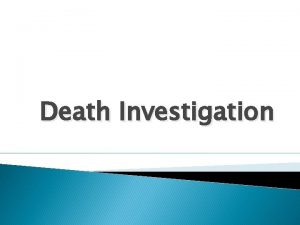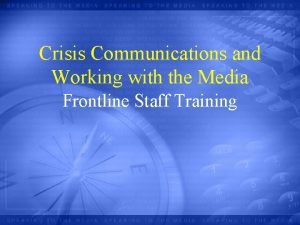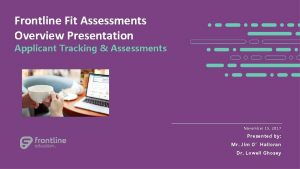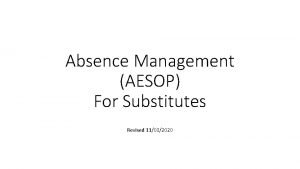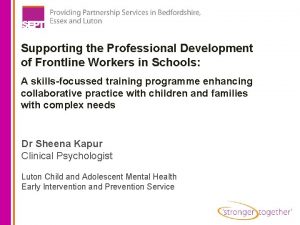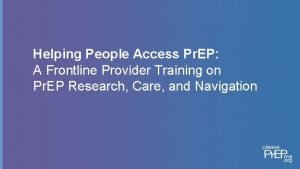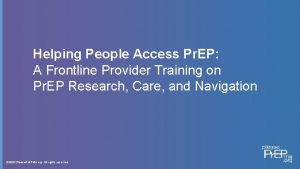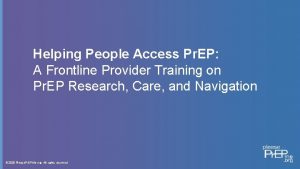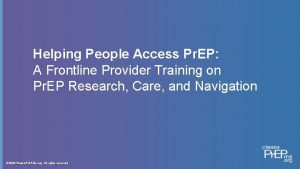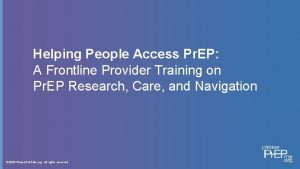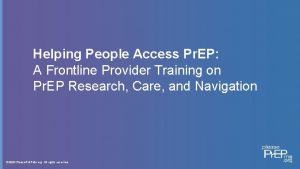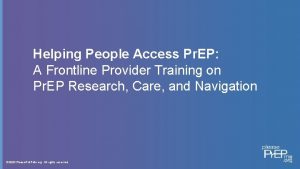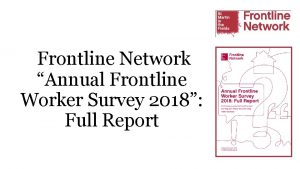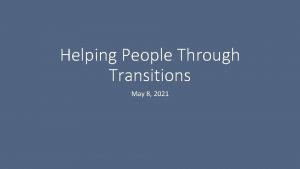Helping People Access Pr EP A Frontline Provider














- Slides: 14

Helping People Access Pr. EP: A Frontline Provider Training on Pr. EP Research, Care, and Navigation © 2019 Please. Pr. EPMe. org. All rights reserved.

Helping People Access Pr. EP: A Frontline Provider Training on Pr. EP Research, Care, and Navigation • • • Series module titles • Module 1: Introduction to Pr. EP Module 2: Pr. EP Science Module 3: Client-Centered Navigation Practices Module 4: Initial Assessments: Getting to Know Your Clients © 2019 Please. Pr. EPMe. org. All rights reserved. • • Module 5: Linkage to Pr. EP Care Module 6: Paying for Pr. EP Module 7: Starting Pr. EP, Adherence, and Ongoing Pr. EP Care Module 8: Self Care and Healthy Teams

Alan Mc. Cord Please. Pr. EPMe © 2019 Please. Pr. EPMe. org. All rights reserved.

Helping People Access Pr. EP: A Frontline Provider Training on Pr. EP Research, Care, and Navigation Module 4: Initial Assessments: Getting to Know Your Clients © 2019 Please. Pr. EPMe. org. All rights reserved.

MODULE 4: INITIAL ASSESSMENTS: GETTING TO KNOW YOUR CLIENTS Topics and Themes • Building trust with clients • Sexual history and current HIV prevention strategies • Health insurance assessment • Pr. EP education needs • GUEST PRESENTER: Ashley Tolliver Youth Health Advocacy Coordinator Broadway Youth Center © 2019 Please. Pr. EPMe. org. All rights reserved.

MODULE 4: INITIAL ASSESSMENTS: GETTING TO KNOW YOUR CLIENTS Starting Off Right: Communicating with Clients Your attentiveness, tone, and body language can affect whether clients feel good about coming back to your site for ongoing Pr. EP care and services. • Greet the client with a smile when they enter the waiting room or your office. If you can’t help them immediately, let them know you’ll be with them shortly. • If the client can’t be seen at their scheduled time, let them know as soon as possible and inform them how long the wait will be. When you’re ready for them, be sure to thank them for waiting. © 2019 Please. Pr. EPMe. org. All rights reserved. • Check your tone and body language: • • Speak with a natural pace and tone Make eye contact Smile genuinely Sit upright with arms down, not crossed Keep hands and feet still, not fidgeting Lean forward Nod while listening Wait for the client to finish speaking before you respond

MODULE 4: INITIAL ASSESSMENTS: GETTING TO KNOW YOUR CLIENTS Establishing Trust with Your Clients As part of the initial assessments for Pr. EP, get to know your clients and start building a trusting relationship. • Introduce yourself and explain your role in the client’s Pr. EP care or services, so they understand why they are seeing you and how you can help them. • Establish a rapport. Make eye contact, and maintain open and attentive body language to help your client feel comfortable and heard, and to show that you’re glad they came in. © 2019 Please. Pr. EPMe. org. All rights reserved. • Learn about the client’s perspective and attitudes around Pr. EP and HIV prevention. Be sure to ask if they have any questions, and whether they have any worries or fears about Pr. EP. • Ask open-ended questions to permit more detailed answers rather than a simple “yes” or “no” (e. g. , “What have you heard about Pr. EP? ” vs. “Have you heard about Pr. EP? ”).

MODULE 4: INITIAL ASSESSMENTS: GETTING TO KNOW YOUR CLIENTS HIV Prevention Needs Assessment The HIV prevention needs assessment may include: • the client’s goals, or what they hope or want to change • condom use history • number of partners (known and unknown HIV status) • STD diagnosis history • PEP use history • desire for family planning © 2019 Please. Pr. EPMe. org. All rights reserved. • use of erectile dysfunction meds • transactional sex history • current use of alcohol and/or other substances • history of intimate partner violence • client’s and partner’s preferences for HIV prevention strategies • possible barriers to seeking Pr. EP services

MODULE 4: INITIAL ASSESSMENTS: GETTING TO KNOW YOUR CLIENTS Health Insurance Assessment Inquiring about a client’s health insurance can provide clues to: • how engaged they are in the health care system • how motivated they may be about Pr. EP The health plan assessment may include: • current insurance status, recent history • inquiring if they understand how it works, have used it recently • type of insurance/health care: through an employer, COBRA, self-insured, state/federal program (Medicaid, Medicare, Veterans Administration, Indian Health Service, etc. ); on their own plan or on someone else’s • age, income, family size, disability, veteran status • deductible, out-of-pocket costs (co-pays, co-insurance), out-of-pocket maximum • pharmacy benefits • patient assistance programs, if needed © 2019 Please. Pr. EPMe. org. All rights reserved.

MODULE 4: INITIAL ASSESSMENTS: GETTING TO KNOW YOUR CLIENTS Pr. EP Education Session Providing basic Pr. EP information may include: • how to take it, medical visits and lab work, and Pr. EP benefits and limitations The education session may also include: • safe-use and risk-reduction counseling • possible side effects, treatment options • baseline and ongoing tests, schedule for medical visits • Pr. EP adherence and medical visit retention • long-term HIV prevention safety • when and how to stop taking Pr. EP • symptoms of possible acute HIV infection • benefits/concerns in case of pregnancy or breastfeeding • how their insurance works • what medical costs they are responsible for © 2019 Please. Pr. EPMe. org. All rights reserved.

MODULE 4: INITIAL ASSESSMENTS: GETTING TO KNOW YOUR CLIENTS GUEST PRESENTER Ashley Tolliver Youth Health Advocacy Coordinator Broadway Youth Center she/hers © 2019 Please. Pr. EPMe. org. All rights reserved.

MODULE 4: INITIAL ASSESSMENTS: GETTING TO KNOW YOUR CLIENTS Ashley Tolliver Broadway Youth Center © 2019 Please. Pr. EPMe. org. All rights reserved.

Thank you for your time! For further reading and tools, download the resource guide accompanying this module. Please complete the post-session survey. Thanks! © 2019 Please. Pr. EPMe. org. All rights reserved.

Acknowledgments and Permissions Please. Pr. EPMe is grateful to the National Library of Medicine and the National Coalition of STD Directors for funding the development and production of this course. Updates and permissions: • All efforts have been made to provide current data and information. Training modules will be updated as Pr. EP research, access, and clinical guidelines evolve. • It is intended that these modules and individual slides be used as prepared, without changes in either content or attribution. We ask users to honor this intent. • The complete slide set is available for download at www. pleaseprepme. org/prepnavtraining. © 2019 Please. Pr. EPMe. org. All rights reserved.
 23 helping verbs list
23 helping verbs list Proda provider number
Proda provider number Frontline quality assurance
Frontline quality assurance Frontline ownership
Frontline ownership Panagiotis karras
Panagiotis karras Frontline excellence
Frontline excellence Frontline fitness warehouse
Frontline fitness warehouse Early fly
Early fly Frontline media
Frontline media Frontline applicant tracking
Frontline applicant tracking Frontline defense systems
Frontline defense systems Aesops frontline
Aesops frontline Grraacceess
Grraacceess Frontline energy login
Frontline energy login Frontline inside the teenage brain
Frontline inside the teenage brain


